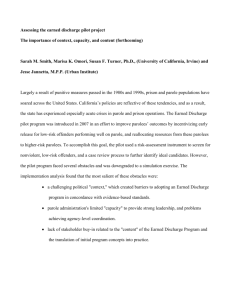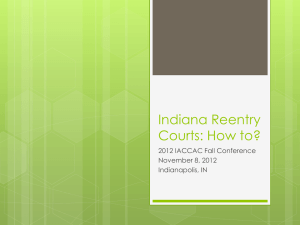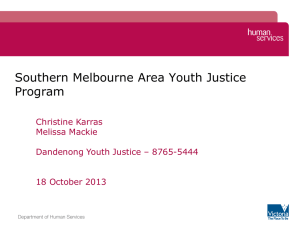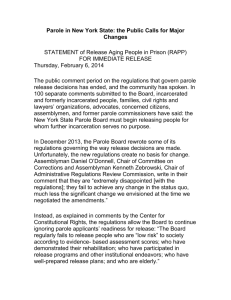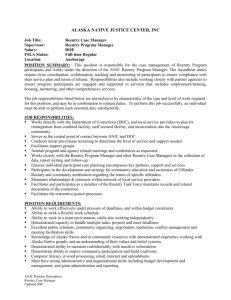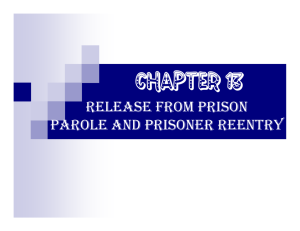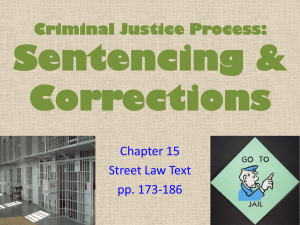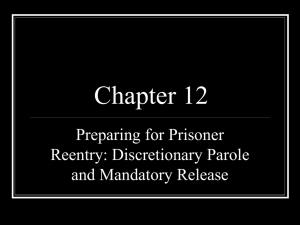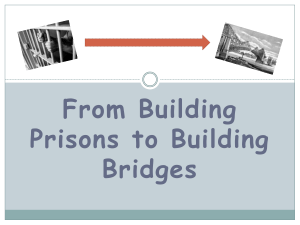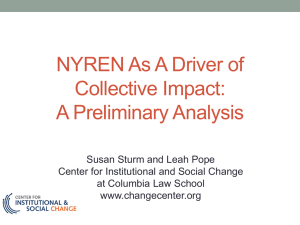California Parolee Reentry Court Evaluation
advertisement
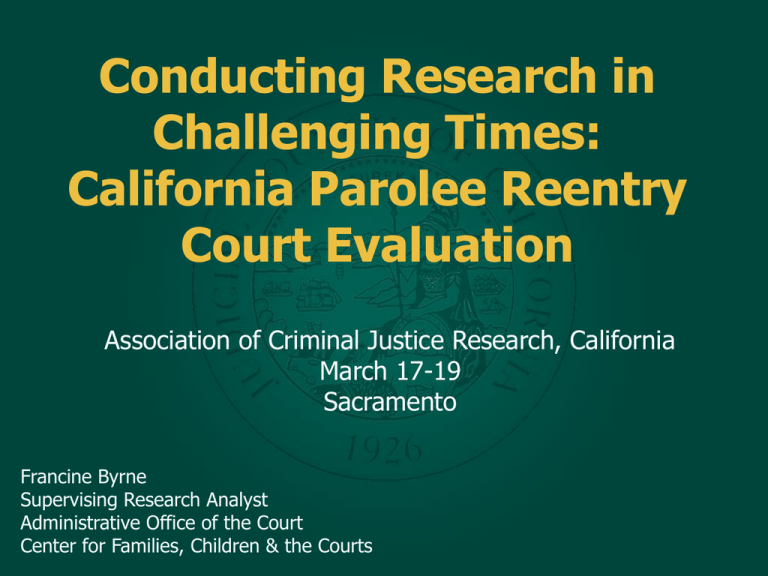
Conducting Research in Challenging Times: California Parolee Reentry Court Evaluation Association of Criminal Justice Research, California March 17-19 Sacramento Francine Byrne Supervising Research Analyst Administrative Office of the Court Center for Families, Children & the Courts Today’s presentation • Background on California parolee reentry court project • Review of relevant research • Overview of evaluation • San Joaquin presentation California Parolee Statistics • California Prison overcrowding largely driven by parolees • 2/3 of parolees return to prison • 6 out 10 admissions to CDCR on any given day returning parolees • In the last 20 years parole revocations increased 30 fold in CA Parole Violations and Revocations in California, Grattet, R., Petersilia, J., Lin, J., 2008. How did we get here? • Determinate sentencing laws • Increased supervision from 1 to 3 years • Increased revocation time from 6 to 12 months • Increase in mandatory referrals to BPH • Serious and violent offenders • Up to 85% violations (DAPO 2005) • Standard of evidence for revocation is preponderance of evidence (vs reasonable doubt) Parole Violations and Revocations in California, Grattet, R., Petersilia, J., Lin, J., NIJ grant final report 2008. Research Recommendations • Expand mental health & substance abuse programs • Expand intermediate sanctions • Discharge well performing parolees after 1 year • Align risk and supervision levels • Utilize violation instrument • Focus supervision on 1st 6 months . Recent Reforms • Non-revocable parole for lowest risk offenders (NRP) • California Static Risk Assessment (CSRA) • Parole Violation Decision Making Instrument (PVDMI) • Parolee Reentry Court Program . Harlem Parole Reentry Court Evaluation • PRC parolees less likely to be rearrested • Less likely to be reconvicted • More likely to be revoked • Graduates less likely to be rearrested and revoked Do Reentry Courts Work ?, Hamilton, Z. Center for Court Innovation March 2010 Parolee Reentry Courts • 2009 Legislation created collaborative justice model reentry court. ARRA $$ • Designed for parolees that have violated and have substance abuse and/or mental health issues • Changes jurisdiction from parole to courts • Six courts funded: Alameda, Los Angeles, San Diego, San Francisco, San Joaquin, Santa Clara Overview of Evaluation • Data elements collected in each court • Outcomes compared to CDCR Business- as-usual comparison group • Qualitative information collected from site visits/focus groups California Parolee Reentry Court Evaluation • Evaluation report to legislature due three years after 1st entry • Recidivism and revocation mandatory outcome measures • Additional information being requested Evaluation Data • Program Entry Data • Program Activities Data • Program Exit Data • Recidivism Data (6 groups) • Comparison Group Data Program Entry Data • Demographics: Education, employment status, housing status, income. • Substance Abuse and Mental Health Information: Present disorder, history of treatment. • Criminal History: Eligible parole violation, risk level, number of prior commitments. • Program referral type Program Entry Statistics • Average Age = 40.5 years • Substance abusing over 20 years • 63% do not have stable housing • 86% unemployed • 100% have substance abuse issues • 30% have known mental disorders Participant Race/Ethnicity 60% 50% 49% 40% 30% 20% 20% 25% 10% 6% 0% African American Latino White Other Drug of Choice 5% 7% Alcohol & Other 28% 36% Cocaine/Crack Heroin Methamphetamines Marijuana 24% Jurisdiction Type Parole Only 77% Dual Jurisdiction 23% 0% 20% 40% 60% 80% 100% Nearly 75% have high risk CSRA scores CSRA Risk Factor 16% 6% 20% Low Moderate High Drug 26% High Property 32% High Violent Program Compliance • Compliance: hearing attendance, treatment adherence, drug test results, jail sanctions • Custody: Jail days and reason for jail stay • Arrests: Date, type, program response Program Compliance • 6% received jail sanctions in first quarter • 13% Rearrested • 0 revocations Program Exit • Exit Status: Program and parole status upon program exit. • Social Outcomes: Re-measure demographic variables measured at program intake such as education level, employment status, housing status, and monthly income and source. Recidivism • Arrests: Date, type, outcome (convictions) • Prison commitments: Date, type • Days in prison • Comparison group characteristics may change with reallignment Questions? Francine Byrne, Supervising Research Analyst Francine.byrne@jud.ca.gov 415-865-8069
